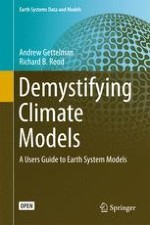Open Access 2016 | Open Access | Book

Demystifying Climate Models
A Users Guide to Earth System Models
Authors: Andrew Gettelman, Richard B. Rood
Publisher: Springer Berlin Heidelberg
Book Series : Earth Systems Data and Models
Open Access 2016 | Open Access | Book

Authors: Andrew Gettelman, Richard B. Rood
Publisher: Springer Berlin Heidelberg
Book Series : Earth Systems Data and Models
This book demystifies the models we use to simulate present and future climates, allowing readers to better understand how to use climate model results. In order to predict the future trajectory of the Earth’s climate, climate-system simulation models are necessary. When and how do we trust climate model predictions? The book offers a framework for answering this question. It provides readers with a basic primer on climate and climate change, and offers non-technical explanations for how climate models are constructed, why they are uncertain, and what level of confidence we should place in them. It presents current results and the key uncertainties concerning them. Uncertainty is not a weakness but understanding uncertainty is a strength and a key part of using any model, including climate models. Case studies of how climate model output has been used and how it might be used in the future are provided. The ultimate goal of this book is to promote a better understanding of the structure and uncertainties of climate models among users, including scientists, engineers and policymakers.